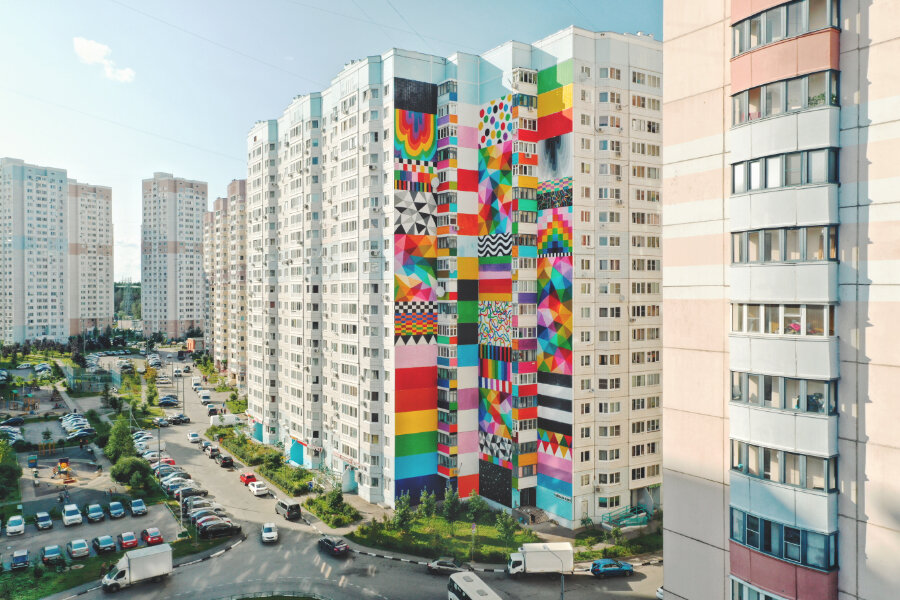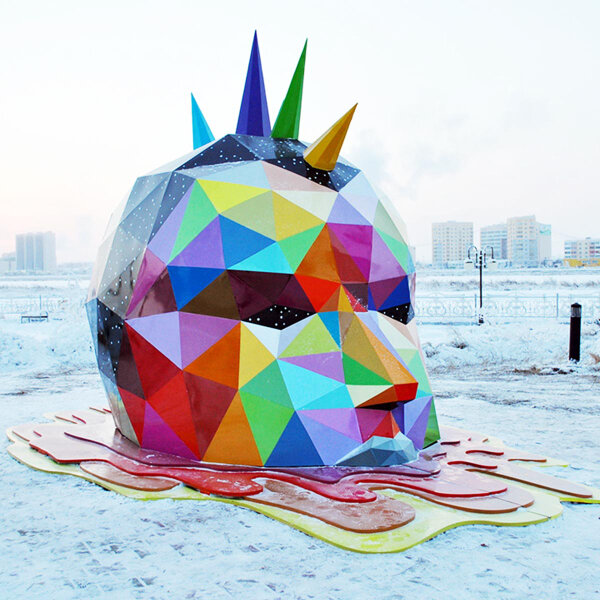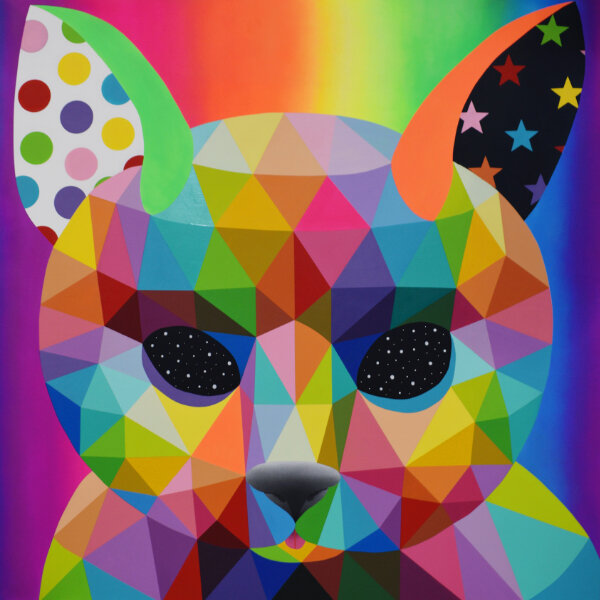
Okuda San Miguel: Coloring the World
Based in Madrid, Okuda San Miguel is internationally recognised for his iconic visual language of geometric structures and multicoloured patterns. His murals, sculptural interventions and gallery exhibitions have attracted collaborations with many cultural institutions and brands, such as Valencia’s prestigious Falles festival, the Titanes project, which promotes social inclusion through art, and his commission to create a spectacular series of sculptures for Boston Seaport in the US.
Pictoplasma: How did you get into street art?
Okuda: I started out painting abandoned factories and tracksides in Santander, around 1996. My parents had a bar and I spent a lot of time in the street, waiting for them to finish work. And I’d spend all day drawing at school. All of these things led me to paint in the streets. Thinking back to those days, almost all of my friends have since pursued different paths, but some a bit like mine. If I hadn’t had the experience of growing up with US culture and nineties rap and spending time with my friends, I wouldn’t be where I am today. Everything that has happened in my life is an important part of who I am. I never had an objective. I never had a goal. I just wanted to do what makes me happiest. What I needed to be happy was to create above anything else, above money or whatever. I’ve always believed that the only thing that makes me happy is creating. It’s my passion.
“Being an artist is something that’s inside you. It’s something you’re born with, a way of living, a constant.“

Can you describe your evolution from graffiti to a broader kind of art practice and understanding of art history?
When I painted graffiti in the street, my biggest inspiration came from the world of graffiti and street art. Above all, German artists like Daim, Seak and Loomit, people like that, and Os Gemeos and Herbert Baglione. When I moved to Madrid in 2000, I learned a lot of things: colour theory, the history of art, sculptural and art techniques – all of which inspired me – but I also learned things beyond the academic. I began to find more inspiration through the artists I discovered at art school and in the art world: surrealists like Max Ernst, Salvador Dalí, René Magritte – above all, Hieronymus Bosch. I think this was the biggest factor in the development of my work. But it also coincided with meeting more people from the street art scene and starting to travel to international festivals. I think this all fed into my development. Now, my biggest source of inspiration is travel and being surrounded by different artists and friends. That inspires me to grow. I’m really inspired by Sixe Paredes, Felipe Pantone, Tomokazu Matsuyama and Keiichi Tanaami. And Murakami, Yayoi Kusama … so many names. I no longer only look to surrealism, but to all areas of art history and the art world. For me, being an artist is something that’s inside you. It’s something you’re born with, a way of living, a constant.

How did you develop your signature style of fractured multi-colours?
I think it was a slow evolution. In the beginning I started in the streets doing letters. Then, I was mixing letters with characters, and the next step was a grey season. I started painting strange ephemeral architectures and added realistic grey bodies around them. By 2009 or 2010, I was fracturing everything into geometries, and I started using all the colours of the palette. I have the chromatic circle of colours in my brain and I need mathematics to put all the different colours into a perfect volume. When I understood that, I started to feel as though that was intrinsic to my style.
“There’s a sense of freedom in working at heights. It’s almost as though I’m in the clouds.“
You work in different media. Can you talk about how you approach these and what each medium requires of you?
I have different processes and approaches for different types of interventions. For large-scale murals, I freestyle, without a sketch. I just use photographs or stories downloaded from the internet based on what I want to transmit. Then I go straight to the wall. I use a long pole and a brush to sketch out. Then I start filling in the background. As the work progresses, the details become clearer. For me, there’s a sense of freedom in working at heights. It’s a view no one else has of the city, of the skyline. Especially at sunset, at the end of a hard day’s work. Or after a few days, when we finish working on the building. That feeling of pride at the end of the day, of making progress and having that view of the city that no one else has, it’s magic, it gives me an incredible sense of freedom. When I look at the hustle and bustle of modern life, of people’s daily routines, I feel far removed from it and really free. I’m only concerned with the details and elements for the mural, I don’t care about what’s happening down below. It’s almost as though I’m in the clouds.

When I completed Kaos Temple in 2015, I realised something. I became aware of the communication and incredible contrast between my contemporary, almost digital language, and classical art and architecture. Kaos Temple was followed by more projects, another two churches (11 Mirages to the Freedom, 2016 and The Church of Cannabis, 2017), and a castle in France (Skull Mirror, 2017). These connections and contradictions are incredible, and I hope to experience them more often. In other words, I am looking for that contrast. With classical architecture, I feel as though the architecture provides me with a script to read. So, while I approach a mural like a canvas for figurative painting that communicates a message, when I work with the full building, I try and let the architecture speak for itself. It’s a process of abstractions, taking the patterns and geometry of my work and playing with the architecture. I read the architecture to find out what I have to do. It’s a whole lot of fun.
It’s a completely different process for sculptures, where I need my team. I start with a sketch and photos from the internet, animals and other references, and elements and characters from my paintings and murals. Then we create a 3D sketch that is used to produce the mould. From the mould comes the final piece, which is painted and varnished in the studio. My 3D process is probably the opposite of what you would expect. I start with the composition, as if I had the grid of a 3D programme in my head.

You also devote some of your time to social practice.
In addition to all my international projects, we created Colouring the World in response to the need to achieve a social balance. It’s about having projects that help people, that can change environments and above all, inspire new generations. For an example of our work, a group of kids approached us with €70 that they had collected to transform their school. They had holes in the shutters and other problems. We ran a crowdfunding campaign to give the school a makeover. It’s about using our influence to motivate people, to make change. That’s the motivation behind creating the foundation.
“I feel super safe and secure because I am just focused on creativity.“
You pull off huge projects and are constantly on the move doing things. Can you tell us more about the group of people that you’ve built up over the years who help you?
I started to travel fifteen years ago, and I was traveling alone. I started to work with my manager Óscar Sanz, who I still work with today, he is my friend and I love him, and we grew up together. As we needed more people, it grew organically. Now, we are 25 people and I feel like we are a big family.
Growing means taking risks. How do you ensure a sense of security as you take on these risks?

I feel super safe and secure because I am just focused on creativity, and each person in the team is in a different position taking care of something specific. We have people working with management and budgets, others working on graphic design and 3D, and others working in the studio and producing everything. It’s a lot of people doing different things, but that is why I don’t feel stressed, because I am super focussed on creativity.
You also make work with your mom and your sister.
Yes, they live in the north of Spain, close to the beach. I travel more than ever before, but we talk every day, and I feel very close to them. They produce all the embroidery for my works. I draw on a canvas and put numbers for the different colours, and they do the embroidery.
You come from an urban art background, you moved into fine art, you do big public works. Have you ever felt any disrespect within the world of fine arts coming from an urban art background?
In Madrid, I feel ok. Up in the north of Spain, where I’m from, I don’t feel very comfortable with the typical fine art people. For example, when I painted the lighthouse, there was a huge controversy in the news because the lighthouse is a cultural heritage. But I don’t care, because in the end it is a cement cylinder. And by now, more than 400,000 people have come to see it and it is the most visited monument in the region. I don’t care what people think, because I come from graffiti.
Interview by Pictoplasma published in Pictoplasma Magazin – Issue 2: Character Care, 2022
- 515 views
- 0x empathizes